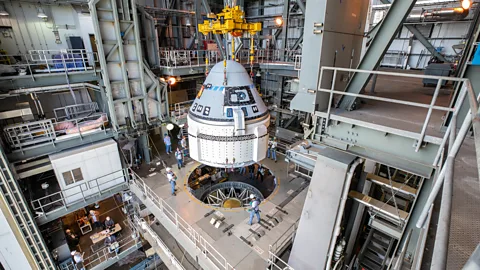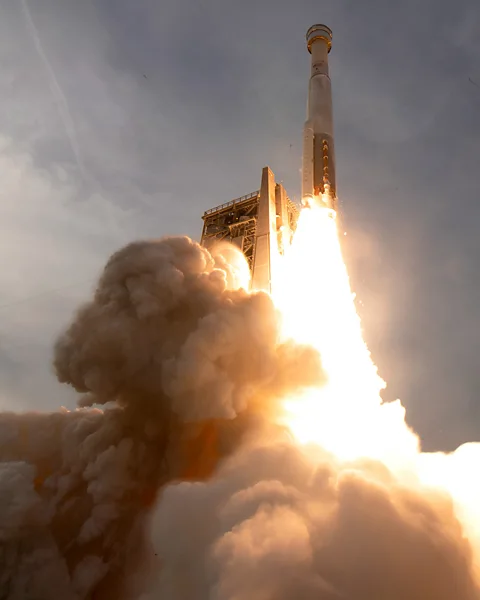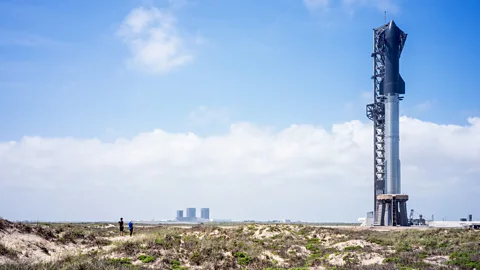Starliner: The US space industry's next big thing?
 Nasa
NasaAstronauts are preparing for launch in Boeing's new Starliner. What does the spacecraft mean for the future of the US space programme?
When the Space Shuttle Atlantis rolled to a stand on the runway at Kennedy Space Centre in 2011, ending 30 years of the manned shuttle programme, it left Nasa with a problem. Without enough government funding to build a replacement while the shuttle was still flying, the US had no means of launching its astronauts into orbit.
The only way to fly a crew to its own orbiting laboratory on the International Space Station (ISS) was to pay some $80m (£64m) for a seat in a cramped Russian Soyuz capsule.
It seemed extraordinary to many that the nation that had landed men on the Moon, built and serviced – in orbit, no less – the Hubble Space Telescope and assembled a giant space station was now relying on a 45-year-old spacecraft built by its Cold War rival.
As relations deteriorated following Russia's invasion of Crimea in 2014, the embarrassment was further compounded by tweets from Russia's Deputy Prime Minister Dmitry Rogozin.
Responding to the introduction of restrictions on US technology exports he wrote: "After analysing the sanctions against our space industry I suggest the US delivers its astronauts to the ISS with a trampoline." In case that message was too subtle, he also posted a picture of a trampoline with a Nasa badge.
 Nasa
NasaBut Nasa had a long-term plan – the Commercial Crew Program (CCP) – and, after 13 years, the first crewed launch of Boeing's Starliner spacecraft means it is finally being fully realised. The viability of the CCP model, not to mention Boeing's already fragile reputation depend on a successful test flight.
"It's been a long road to get here," says Makena Young, a fellow with the Aerospace Security Project at the Center for Strategic and International Studies in Washington DC. "I think it's a reminder that although we have a good record, space is still really difficult and it's hard to be successful."
The idea behind the CCP is that instead of Nasa designing, building and owning its spacecraft, it buys seats from commercial operators. You could liken it to purchasing a seat on an aeroplane, albeit a seat that costs more than $55m (£44m) for a return trip and involves billions of dollars of taxpayer investment to construct the vehicle in the first place.
After funding the initial development of five potential commercial spacecraft, Nasa narrowed the field down to two in 2014 (you can see the timeline and all the costings here): aerospace behemoth Boeing's Starliner, and space upstart SpaceX with its Crew Dragon.
By the end of 2019, the race to launch between the two space rivals appeared to be neck and neck. Then, following a near-disastrous test flight of the first uncrewed Starliner in December that year, and a series of subsequent hardware failures to the Boeing craft during further testing, SpaceX took the lead. In May 2020, the first Crew Dragon lofted Nasa astronauts Doug Hurley and Bob Behnken into orbit.
Meanwhile, Starliner's pioneer astronauts, Barry "Butch" Wilmore and Suni Williams, have been patiently waiting a further four years for their chance to fly a week-long mission to the ISS in what Boeing promises will be a "next generation space capsule".
 Boeing
BoeingBoeing's Starliner website reads like a car brochure, reflecting its commercial proposition. The reusable spacecraft promises customers precision software, advanced "cruise control" and a spacious interior. In fact, the capsule (and it is more of a capsule than anything resembling an ocean liner) can carry up to seven crew, although typically under contract to Nasa it will ferry four people to the ISS.
Boeing has also designed new blue-coloured spacesuits, overtly distinctive to Dragon's monochrome designs. Offered in a range of sizes, the suits promise astronauts greater comfort and flexibility.
"They've spent a lot of time, a lot of Nasa money as well as their own money to get this across the finish line," says Young. "Being able to successfully and safely deliver this crew to the ISS will be a really big accomplishment and show that all that time, money and effort has been worth it."
For Boeing and SpaceX's primary customer, Nasa, the benefit of having two commercial providers flying two different spacecraft almost guarantees sovereign access to space. Even if one spacecraft is grounded for some reason, the other is likely to be available.
"Nasa always wanted two providers, but it was very big unknown at the time [CCP was conceived] whether or not these companies could actually deliver," says Jason Davis, senior editor for the Planetary Society. "It's a big deal for Nasa because this validates a strategy that they've put in place almost two decades ago."
The competition should also drive down prices for both the agency but also other potential clients, opening up human spaceflight to a growing number of commercial operators.
 Getty Images
Getty Images"Nasa very much wants to establish a market for low-Earth orbit," says Davis. "So that crew and cargo transportation becomes independent from them."
Now, for the first time in history, if a company wants to buy a seat on a spacecraft – or even hire a whole capsule – they have a choice of providers. Texas-based Axiom Space has already chartered three private flights in Crew Dragon spacecraft to the ISS and is planning several more including a possible UK mission flown by an all-British crew. In future, it is hoped that Dragon and Starliner could also ferry astronauts to and from privately operated space stations.
"The ISS will be retired sometime around the end of this decade, and it will be replaced by a number of [private] space stations," says Libby Jackson, head of space exploration at the UK Space Agency. "These stations will still have anchor customers in the form of Nasa or the European Space Agency (Esa), but there are opportunities to develop new materials, new drugs that you could only manufacture in space – I'm really excited to see what opportunities that free market thinking will bring."
But although access to space is increasingly about competition between companies, when it comes to human spaceflight, geopolitics and national pride are still important. Despite the war in Ukraine, the US is still co-operating with Russia on the ISS and US astronauts are still flying in Soyuz capsules and Russians in Crew Dragon. When that agreement comes to an end, and unless there are some major political changes in Moscow, the US and Russia will once again become rivals.
Soyuz, however, will be more than 60 years old by that time, so it is not Russia that the US will be worrying about. With its own space station, new spacecraft and plans for crewed missions to the Moon, China is increasingly being seen as the world's second space superpower.
More like this:
"China has really emerged as a powerful nation in space," says Young. "We regard them as the number two behind the US in our annual strategic assessments."
"Being able to have these resilient, robust, reliable, ways to get into low-Earth orbit for the US is incredibly important in maintaining that strategic advantage and being able to show the world that we have more than one way to get to space," she says.
After the successful unmanned flight of its Orion capsule ahead of its planned Artemis lunar missions the US has gone from having no spacecraft in 2011 to three in 2024.
No need for that trampoline now.
--
If you liked this story, sign up for The Essential List newsletter – a handpicked selection of features, videos and can't-miss news, delivered to your inbox twice a week.
